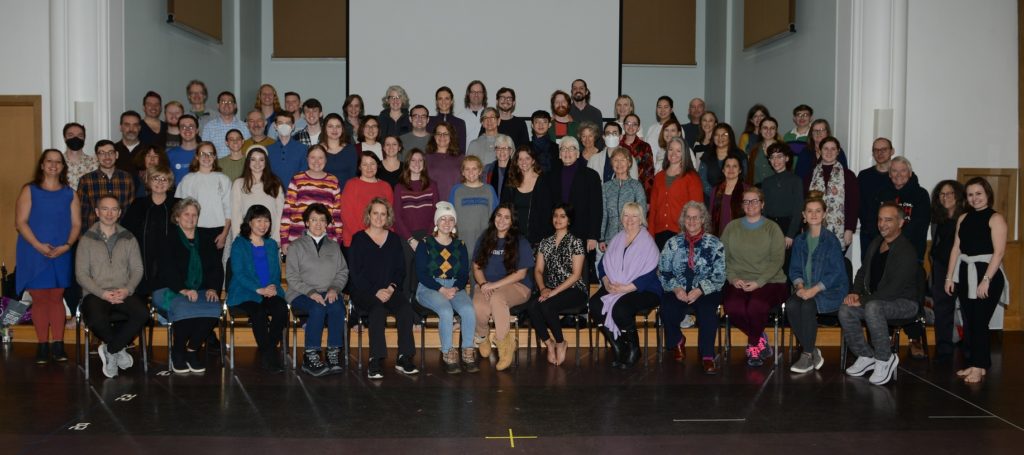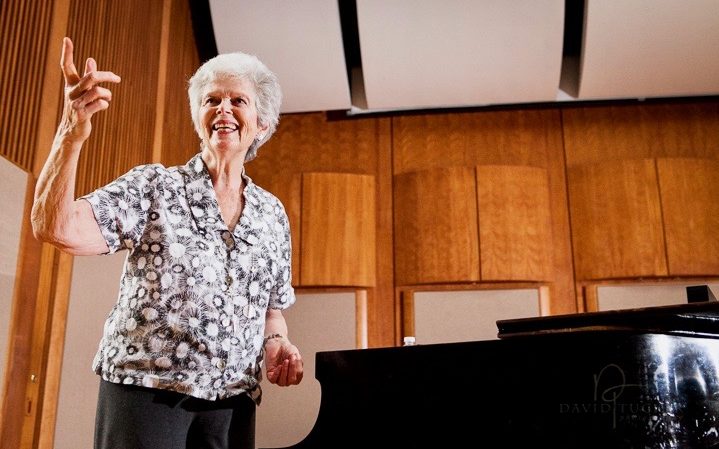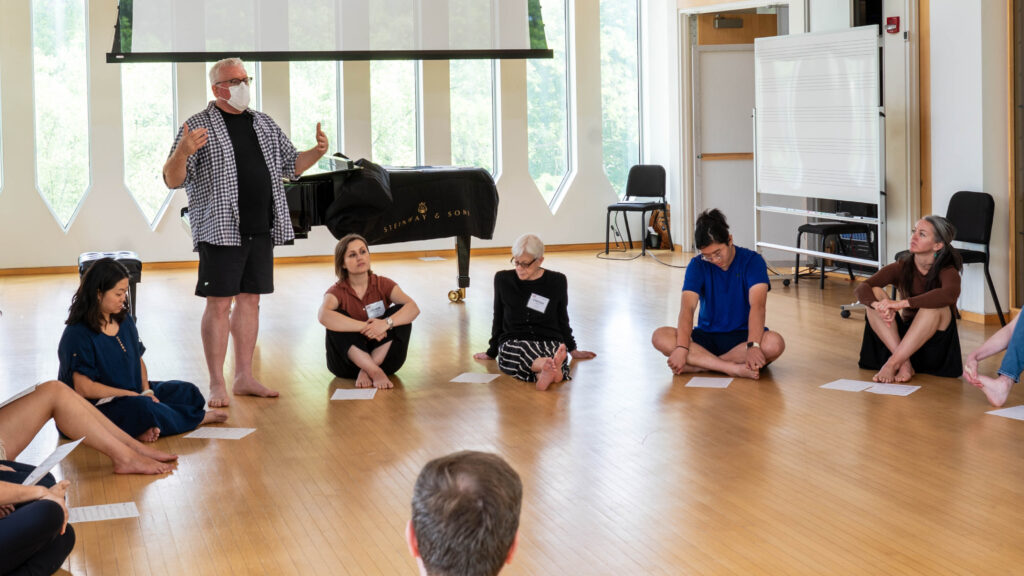Post-License Solfège: The Chromatic Scales
With Lisa Parker, Diplôme Supérieur
Recorded June 20, 2014
Members Only Resource
Please log in or become a member to watch this video.
I would like to focus on the chromatic scales
because I, uh, I don't know whether you all teach them, uh,
or not, but I want to get into them the, uh,
the way I teach them.
So, um, let's just warm up the voices first,
would you stand up, please and just begin to stretch
and accompany yourself vocally.
Woo,
woo,
woo.
Good.
Great. Okay. So we're gonna start with a high note
and we're gonna list it on down
and see if we can end on dough.
And if you don't have perfect pitch, perfectly fine.
So let's just hit it a note that's very high in your range
and just begin to zero in on what you think is dough.
Okay, here we go.
Okay, let's come into a circle and do it again.
And, and like a little beehive hive. Okay.
So here we go.
Whoa.
Okay. I heard it
sort of, yeah.
So let's, let's take, take the lowest
and take the highest note.
Take every note that you heard that was more or less dull.
Okay. And just keep, go, keep that going.
So, wander around, see what different people feel about it.
Yeah. Wander around. Oh, wander around. Yeah.
That's what Mr. The, the tuner feels about it.
The tuner is wrong. Well, a lot of times that's correct.
So we're, we're definitely in the, in the register.
So, uh, this Steinway tells us that doe is,
okay, good.
So let's just sing the D scale
and let's paint it, uh, in, in the air quarter notes
other hand,
when you get to the top, can you please just turn around
and see if you can make it all one phrase instead
of start again.
Okay, here we go. And either hand.
Beautiful. So can I put you into groups
of maybe four people?
We're gonna do it in Canon.
So you're going to start, and
you'll be the next group and Oh, good.
So we should hear triads, right? And do it twice.
Here we go.
Yeah. When you get to the bottom, take a breath,
and then you'll be rhythmically, right?
So they can be,
and then you'll get a chance to breeze too.
Let's start it with this group.
Okay, great. Now I'm going to ask eight people.
We are, uh, 12 people, so 8 0, 13 people.
I, I'll, I'll be off the side. All right.
Are you gonna create a living scale?
So you're gonna stand up
and I think we'll start it from the point of view of the,
uh, observers who can sit down.
So would you be doe Ray any thought?
Yeah. Uh, just in a line here.
All right. Would you show us your half steps, please?
Um, yes. Stand close together so that you can maintain it.
'cause you're, you don't in the scale have to do that.
Uh, okay.
Now do you wanna just move the ends forward a tiny
bit so you can see each other?
Okay. So come on and sit down here.
Would the tonics please identify themselves? Okay.
Would you look toy quiet? Some kind of a movement?
Okay, here's a movement. Yes. All right.
This would be a, a good one.
Uh, would the dominant please identify
the dominant, would the dominant seventh chord
please present itself?
Good. And with the tonic cord, please present itself.
Good. So we have a wild card here too, don't we?
And that is number six.
And he can be part of either, actually.
Alright, so I need somebody now, uh,
who is going to play a tune on this,
um, living scale.
Okay. Oh, so Ann is going to point to you
and, uh, it's gonna be as long as ya
two measures, then you are going to, oh,
did I say that too fast?
Uh, everybody, it's the same length as,
it's basically two bars.
Oh yeah. You can have long notes,
you can do whatever you like, but you have two bars.
And then Ann is gonna go
and the dominant seventh is going to sing
and then resolve on the tonic.
Okay. One measure. Now everybody here can sing
that dominant seventh and the tonic when we get to it.
All right? So Ann is going to point
to different people, right?
'cause you're gonna play on this as if it's a real scale.
Me dog. So long.
Beautiful. Okay. Okay, good.
I'm going to give you a scale. Thank you, Anne.
That was lovely. I'm gonna give you a
scale from piano.
A do to do scale.
And would you listen to it and readjust your half steps?
Does, are you satisfied? Can you find the half steps?
Everybody?
Okay. Alright. With the tonic, please identify.
Okay, let's all sing it together. Here we go.
Yes, yes, yes. Good. Would somebody like to create a melody?
How about you Ako? And do you have
the dominant seventh chord?
See if you know that you, whether you are in,
so you have,
yes.
Okay, so that's our dominant seventh chord.
And then the tonic cord is
right second two
Bars.
Y you know, Anne's was four bars long. It's okay.
Just, Just do, do your tune
until you're ready for the dominant.
And then do it.
Yes, yes. I, I wanna do it once again.
And would you make it sound
as if one person is singing rather than me?
Although we all have different tams,
but let's see if we can connect it.
So it sounds like a melody. Yeah.
Let's do the scale once again.
And would you join us on the scale? Get your half steps.
I don't see your half steps. Thank you. Yes. Good.
Let's, let's do the scale again and practice that.
Uh, leg out singing.
Okay, let's, let's tune it up just a little bit.
Could you please sing the scale?
Here's, and let everybody sing the
skin. Here we go.
And
You present yourself
the,
okay, good.
So now aco, can you, um, play your tune on them?
Half steps have, have gotten a little funny.
Yeah, there we go.
Okay, good. Good. That's good. That was very nice.
Would the, would you four come
and take the places of four people that are here so
that everybody gets a chance to Well,
They get to pick.
They do.
Okay. New scale
tonic note, please.
Yes. But if you are the tonic note, would you please?
Thank you. Yes.
Half steps. Can you make your
half steps clear?
Good. Alright, so let's all sing it. It's, it's what scale?
Lobby. All a flat major. So let's all sing it together.
Okay. Could somebody come and make a scale with it?
Make a tune.
So,
Beautiful, dominant seventh chord.
Yeah, there's one of those
In every scale.
It's head.
Very good. Okay, so let's now begin to,
um, the, the wonderful thing about the CROs scales,
the chromatic scales, is that it distinguishes
between the diatonic half steps
and the chromatic half steps.
So, uh, I can't see the half step here. No, I see it.
We're in, we're in a flap. Yeah.
Let's go back to the key of C.
Would you adjust your half step? Beautiful.
How about GI love this game.
G, Uhhuh.
Okay, great. C. Beautiful.
All right, now, so we've got whole step.
Whole step, and then we have a diatonic half step.
So do you understand what I'm talking about?
The diatonic half? Okay.
So we have room for somebody
to stand behind here
because you are matic half step.
So we have where's do,
Do?
And so we have no, do
we We're back in C major.
Let, let's all sing the scale of C majors. Do
good now.
Well, what we say is,
because we're going up, coming down, it would be
now raw is a part of, is are you movable? No,
I just, that Oh, oh, oh, okay.
That's, that's, that's, it's, you could,
You could, absolutely.
I just can't think that way.
But anyway, I, so
we're gonna add the,
eventually everybody's gonna be on board here?
I think. So this is really gonna look very much like a
piano, because I have, do,
Do
I have room for something in here that somebody, okay.
Mm-Hmm. So now I have us.
So
do, do, do
Good. Where else
do I have one?
Monica, can you find a place to put yourself?
Come on down here. It's, it's,
how do you pronounce your first name?
Elda. Elda. Okay. Okay. Can you stand a little bit closer?
So now we have a,
okay.
Jack or that Elda el Elda. Elda. Yes. Elda.
Here's a whole step. So we need another half step here.
So let's start with,
So
You're a little bit sharp.
Oh,
Oh, Yes.
Let's let Mr. Steinway help us. So we had,
okay.
Uh, Jack, I need you,
there's another whole step here.
So
let's start at the top.
I shouldn't have done That.
So
If it goes up, you take the, uh, accidental
of the one before.
If you're going down, you flat. So let's do it.
Now we have actually the scale, don't we? Bravo.
Thank you so much for all being here. Here we go.
Soul love.
Yes, yes, yes, yes. Beautiful.
So would you all sing all of them?
And would you conduct at the same
time? What time did we finish?
Uh,
12, 12, 11, 10.
Okay. Okay, so here we are. Am I going sharp or,
Oh, Would you like to curve around a little bit more?
So you can all see each other?
It's like one of those piano organs from
Oh yeah. Right.
So we want to see the diatonic half steps.
They are glued together.
Everybody else is a black key, is a, you know,
is a chromatic half steps, and they are behind the scenes.
So here we go.
We're gonna conduct it and, and sing it in rhythm.
So the diatonic half steps, all the notes
of the diatonic scale are on the beats.
Everything else is in between, in between the beats.
So we have do,
yeah.
Yeah. It's very hard to tune it, isn't it? Yeah. Uh, yeah.
You start, you start, um,
making the top octave is, is too low.
We're not too bad. But I'm going to play this
and you are going to sing as if somebody was out there.
I'm going to keep you in. Here we go.
And
Beautiful. Could
you just step that rhythm anywhere, come out
of your little piano keyboard and just sing
and step Okay.
With the rhythm. Everybody. We're gonna be all singing it.
Yes. Step the rhythm and sing. Here.
We,
I want you actually to step the rhythm
that you are singing.
Singing. So they have me.
Let's do it a little faster or just Yeah.
Conduct it and step the rhythm. So let's do it about
Good, good.
Now I would like to have you shuffle around.
I, I would like to keep you if you're not too tired, um,
standing, because I find this, this actualizes very,
very clearly for people what the chromatic scales are and,
and where the diatonic scales.
So I'm gonna give you a diatonic scale,
and I'd like eight people
to just quickly form the diatonic scale of,
you can just choose a note,
but you're gonna form the diatonic scale.
Oh. So we, we can now be Reconfiguring. Reconfiguring
is,
Yes. Good,
good, good, good. All right. Let's see.
Do we have our half steps? Yes. Is it clear?
I'm done. Yes. I'm just gonna, yes.
Okay, let's have the dominant cord.
Let's build it down from
Good And on cord
Resolving.
Yeah. Good. Okay. So be in your half steps.
And, and now would you pick a note to be,
not, not do, do sharp, but pick another one
You can't hear. You can go
here
and you
Stand right in between.
Okay. So let's sing it now. Here we go.
Yeah. Uh, composers would write it that way.
But in our system we say, oh, dog.
Okay.
Yeah, yeah, yeah, yeah,
yeah, yeah.
Uh, it's, it's hard to tune these.
Uh, let's do it once again. I'm gonna play with you.
Here we go. Singing just your note. Here we go. And
sonic.
Yeah. Good. Okay. Would you break?
And would you all sing the scale with its rhythm?
And then we're going to step it. Here we go. And,
yeah, let's do this again.
I think this is a little bit new for people.
So we, we have,
let's clap the rhythm and, and sing it first.
Diatonic, half stepss are on the beat. Here we go.
Right. Good. So clapping and stepping and singing.
Here we go. And
yes.
Good. This divides itself into three
little parts, doesn't it?
You have,
okay.
So could you step it
with those arrivals, like little phrases.
Here we go. And
So,
And with arm beats now.
So here we go. That was beautiful by the way. Nice stepping.
Here we go. Do you
Think it should be three instead of four?
Not because of the,
They're actually we can phrase And the,
the last beat is accuracy because they work out in four.
They don't work out in three. Here we go.
Roll. Good. All right.
Now I'm going to give you a chromatic scale with its rhythm.
And I want you to form it.
Would you mind facing me so that as I can see it, the scale,
the beginning of the scale is gonna be over here?
'cause I have to keep coming out. Oh, I have.
So you can just, as soon as you know something,
stand there, you know, and,
and look as if you're purposeful.
Okay. This is a new scale.
You know what the tonic is. Would you form the scale? Yes.
Some of you do. So form the scale.
You're here, you're the tonic note. Right?
So the first note, I'm sorry, I don't mean
that he is the first note.
So we have that.
We have, well, are you a chromatic note, Melissa?
Or a diatonic note? Oh,
I'm sorry.
I would like to be dramatic.
Well then you don't go next.
So now we have,
oh,
okay.
We look a little funny. Would you hold up your hand
or, or smile or something?
When I play your note,
are you a diatonic or a chromatic?
Charles,
Could you step, step forward?
Are you
Alright? Let's get,
do you know what scale it is yet?
And then we have, we
have aco.
Are you a chromatic or a dito?
Are you Okay, let me play the,
um, let me play it once again.
Yeah. Because I don't see my diatonic half steps. Mm-Hmm.
Yeah. Yeah. Really make it obvious. Yeah.
And where's the other diatonic half step? Yep. April. Yes.
Yes. There we go. Oh, we've got it. So here we go.
So would you now identify your,
so let's sing the, so who's the tonic?
Am I, am I mixed up here? Oh, yes, yes, yes.
You give us two minutes. Yeah.
Uh, I'm thinking of E-Flat.
Yes.
So I'm playing the wrong scale. Yes.
I'm not quite sure. E the efl.
I'm so sorry because you are, you
Change back.
It's, it's okay.
Don't record that. Alright.
I, it's so interesting to me. Can I ask a question or is I
Yeah, ask please.
Because you know, I heard, I heard E flat initially
'cause, and it was really cool because at first on the way
up it was not clear to me at all.
I was like, wow. And then when we came down
and we landed on,
on the vinyl line vinyl B Cloud, I was like, wow.
It's so clear now. Mm-Hmm.
But what's interesting is when we're looking at it like
this, it's tricky because the,
the half steps are not like a piano.
Do you know what I mean? It's different.
It is different. It looks different because actually
It, the di Half step is between here and Yeah.
And here and here. Does that make sense?
That's what makes it tricky when
you're doing the black keys.
Yeah. This is not a diatonic.
I mean this is not a piano anymore.
I'm sort of borrowing the idea that the half steps are,
that the chromatic steps are between the
We should, But it's not a piano. But then I thought
The change to be flat.
I know. I, I screwed it up. That's alright.
Can we do it again though? Because It's,
let's, let's change to E flat.
Let's change to E flat. So I'll play it,
I'll start it again,
Ray.
Okay. I see two people here. We have do.
She can't meet me anymore. She's not, we're not the piano.
Right?
Well then you, you think you're Ray, are you Ray?
No, she was, she's Ray. I was Ray.
Ray and then Onic.
Alright, let's do the diatonic scale.
Okay. Chromatic, would you put yourself where you belong?
Mm-Hmm.
Sorry.
Okay, let's do it again from the top. Do CC lock.
Okay. Something's funny here.
So
Yeah, let's all sing the e flat scale.
This is one of my favorites
because it really has three very even sections.
So let's clap it.
So we have, yeah. Ba ba ba ba.
Yeah, Let's do it once again. Uh, down.
Okay. Yeah. Alright, good.
I wanted to, um, let's find a seat. Sit in a circle.
I wanted to just do a little sight singing with you.
This, do you wanna bring chairs or sit on the floor? Yes.
Oh. Oh, sit in. Are you okay sitting on the floor?
Oh gosh, some of us. Not me.
Okay. This is a piece written by Bill Bauer,
our very own Bill Bauer.
And it looks scary as anything on the paper,
but actually when you come to do it,
if I have given you two, pass it on
Passive now.
Oh yeah. Okay.
Let me, let me, I'll start at the other end.
Yeah, just pass it down
To transcribe.
Is it on the back? No, the Brahms is on the back
and I've just, the brah is absolutely beautiful.
Uh, but I thought that's the Brahms.
So on the front is the Bower.
Uh, thank you.
So what I'd like you to do is
to just tap eighth notes about like this
as you sing, and let's sing it through with, uh,
just Tata ta rhythm, right?
So this is your eighth note. Here we go. And ta
Ta ta.
Good. Alright, so let's do it with syllables now.
And, uh, you could keep that eighth knot hand going.
Here we go.
Okay. So three, three ohs
Going on there.
So here's dough. Where's Pasha?
So A lot of it feels like an A minor. Yeah.
So you have,
okay, let's see what it sounds like as a cannon, uh,
in three parts.
So let's do 1, 2, 3, 4, 5, 1, 2, 3, 4, 5.
Ah, you, you four together, you four together,
and you five together.
Enter at the first measure.
Now I think you enter, uh, at the
first measure of each line.
So you, yeah. So would you forest start?
Uh, it's, it's fairly slow.
Slow so that you can feel the, uh,
eight notes. Here we go. And
Me
Okay.
Yeah, you have to start. So could you start with, so,
okay.
Okay. Uh, let's, let's, uh, do it with words
and, um, and stand up.
Can I just interrupt in, in down pros, why is
The Yeah. The,
The, in this, the, uh, third measure going down.
Shouldn't that be me, v ray?
Yes, it should. Okay. But very often composers will not
follow the down rules.
Really? Okay.
I'd like to start it in unison
and so that you get the feeling of the phrasing of it
and the line of it dreams.
Dreams that awaken your soul
as you sit in your old rocking chair.
So, and then you'll come in, in unison,
runs all the way through and conduct so that you know
where you,
okay.
Uh, let's, we have to work on that.
And it's, yep.
Now think of, think of law. That's your key.
Can we just do that whole boom? It's a shame.
Oh, it's a shame.
Yeah. I think you've got it. Okay.
Let's do when ready. And,
okay, good.
Let's try it one more time in a round.
Get a little closer together so that you can
not always singing as loud
Of the, That's just where,
where it is supposed to end. Okay. So
We're all cadence there.
Uh, when, uh, yeah,
I think you ca cadence on the a actually right
On the lock there.
The lock Is that part of the it's part of the can, isn't it?
Yes. Yes. This is all part of the can candidate.
So I think part one will go through
and sing all of this and start again.
Part two. Um,
Yeah, you have to wait that one,
one dotted quarter. That's,
That's where you wait.
Exactly. So, um, can, can we just figure it out?
I can't figure it out right now. Sorry.
That, um, just that everybody gets
to sing all three parts and then we end.
So I don't know where part one will be, but,
Uh, we'll have sung the first line again, I think.
Okay. Probably the second line too.
The first and the second line. We should end up being part
Three will not sing the whole can
and part three will end on care.
Okay. Oh, they're never gonna
Get, they're never gonna get to sing that whole
Thing. Oh,
So sorry, but we're running out of time dream.
Here we go. Should,
do you think it should go a little faster?
You rock and
One
Soul Sing a little less strongly.
You have to think back to Sylvie's lesson of how to do
that one measure of, you could actually think
of this as a three measure with an elongated, uh,
ya rock and chair.
Boom. It, it all fits together.
But let's try it one more time.
Don't seem quite so loud. Yeah, we're
Good. We,
yeah. And oh, here we go. And
yeah, we didn't stop.
We didn't stop. You're supposed to start again.
Uh, but I think we're out of time. Thank you Lisa.
It's Bill's fault. Yeah. Maybe we should have done the bras.
No, no, these are for you. Do try the Brahms.
It's absolutely beautiful.
And I think if Bill had been here,
I thought he was gonna be here, but, uh,
he would have accompanied it.
And that's why he said he wants it really slow
because the, the, there's a lot of harmony on each, uh,
you know, each moment of it.
It's very rich harmonically.
So, uh, I, I think it needs the piano myself.
I think it really needs the, the harmony, the piano.
So it's okay. Thank you.
Featured Videos
Beginning Solfège
With Lisa Parker (2012)
Duration: 1:01:31
Members Only Resource
Intermediate Eurhythmics
With Cynthia Lilley (2014)
Duration: 1:24:08
Members Only Resource
Conference Welcome and Keynote Address
With Mary Dobrea-Grindahl (2023)
Duration: 28:44
Free Resource
Beginning Eurhythmics
With Lisa Parker (2012)
Duration: 1:03:47
Members Only Resource
TaKeTiNa: Entering Polyrhythmic Patterns
With C. Fabian Bautz (2010)
Duration: 1:00:17
Members Only Resource
A Dalcroze Approach to Modal Jazz
With William R. Bauer (2024)
Duration: 1:09:53
Members Only Resource





